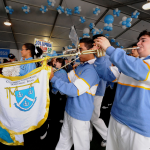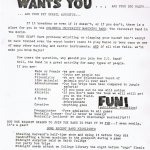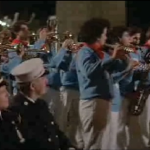Follow the band – a list of practice spaces from 1934 – present.
Significant Events
1904 – Seven College musicians and a high school clarinetist play at the last game of the football season, uptown where the Medical Center now stands; Columbia 12, Cornell 6. The Band leads a victory parade to a popular student hangout, the Lion Café, on 110th Street. The next year, Columbia football is discontinued. The Band dissolves.
1913 – Still no Columbia football, but a College basketball guard spearheads a drive to reorganize the Band. With support from Spectator he recruits 27 fellow students. The musicians rehearse on the top floor of the School of Mines building (now Lewisohn) and play at basketball and crew competitions.
1915 – Football is reinstated at Columbia. The Band – somewhat irregularly – plays on.
1918 – Band is suspended briefly because of war.
1920 – The University hires a part-time Band “coach”: noted bandleader/composer Edwin Franko Goldman, the 20th-century’s John Philip Sousa. The group starts its dual function as both Marching Band and Symphonic Band.
1924 – The University offers academic credit and a tuition break for Band participation.
1926 – The Symphonic Band begins outdoor spring concerts on campus.
1927 – George C. Flint replaces Goldman as coach. During his short tenure, he composes and publishes marches titled “King’s Crown” and “Columbia University Band.”
1929 – The University hires a full-time Band director, Harwood Simmons, a Band alum from the Class of 1925.
1930s – Under Simmons, the Band does national radio broadcasts on CBS and NBC, plays Madison Square Garden, the Brooklyn Academy of Music, and no less than 57 shows at the Roxy Theatre and Radio City Music Hall.
1933 – Columbia becomes the first college band to play Carnegie Hall, is invited to Austria to play at the Salzburg Festival (but declines for lack of funds), and records marches and Columbia songs for the Brunswick label.
1934 – The Band shares rehearsal space with the University Orchestra on the third floor of Hamilton Hall.
1935 – The Band appears (with billing) in its first film, Meet the Professor, a black-and-white Universal two-reeler.
1936 – NBC radio covers the U.S. Presidential election results from Town Hall. As FDR defeats Alf Landon, the Band plays marches to the whole nation.
1940s – Columbia offers a yearly prize – $100 or $150 – for an original band composition, each year’s winner to be premiered on campus. Among the guest conductors at Concert Band performances: Percy Grainger, Wallingford Riegger, and Rudy Vallee. However, as the decade goes on, Band scholarships are discontinued and the Band budget is cut. Add the effects of the war on campus life in general and the Band suffers some lean years.
1946 – The Band’s new coach is Robert Ward, who later wins a Pulitzer Prize for The Crucible, an opera based on the Arthur Miller play. The Band’s office is in a passageway to the elevators on the third floor of John Jay; rehearsals are held in the Casa Italiana. Marching uniforms are U.S. Coast Guard cast-offs.
1951 – The Band’s yearly budget is $1,900; Harvard’s is $15,000, Cornell’s $16,000. A special College Alumni Association subcommittee issues a report noting that between sporting events and concerts the Band plays to a quarter-million people a year, making it one of Columbia’s chief public relations vehicles, but it desperately needs a band room, instruments, and new uniforms. The Class of 1924 offers $8,000 – half for uniforms, half for a uniform maintenance endowment and instruments – if the group will be given a practice room, an office, and storage space. Prodded by the College Dean, the Alumni Association, and the Student Activities office, the University provides room 113 Low Library as Band headquarters, but only after the Class of 1912 pledges $10,000 to renovate the space. Thus the two alumni classes are largely responsible for the rebirth of the Band.
1957 – The Band plays at the Roxy Theatre opening of “April Love,” a movie starring Pat Boone ’58GS.
1963 – The Concert Band plays Carnegie Hall with Lehigh. The Marching Band makes its first TV appearance, on NBC’s The Tonight Show with Johnny Carson, and starts to bill itself as “The Cleverest Band in the World.”
1965 – The Concert Band again plays Carnegie Hall, this time with Harvard, performing the New York première of Aaron Copland’s “Emblems.” Later in the year, the Band moves to 108-110 Dodge, where it has office and storage space but no dedicated rehearsal room; practices take place on the stage of McMillin (now Miller) Theatre.
1967 – The Marching Band, which has been fielding an Eb contrabass sarrusophone, now becomes the first in America to march with an Australian didgeridoo. In the next few years, the Band adds, among other innovative marching instruments, a washboard, a violin or three, and “the world-famous lenthopipe.”
1970s – The Concert Band, originally the Symphonic Band, renames itself the Wind Ensemble. A jazz big band becomes the third division of the Columbia University Bands; it lasts into the 1980s.
1975 – The Band launches Orgo Night, twice-yearly appearances in Butler Library at midnight before the Organic Chem final, and once again takes up residence in a full-service band room, 406 Ferris Booth.
1985 – The Band appears in Turk 182!, a Bob Clark action comedy starring Timothy Hutton, Robert Urich, and Kim Cattrall, and plays the national anthem to start a Mets game in Shea Stadium.
1988 – In the frenzy immediately after “The Game,” in which Columbia football ends a 44-game losing streak, the Marching Band relieves a Baker Field goalpost of its crossbar. When the souvenir proves too unwieldy for the No. 1 train, two dozen Bandies walk it 100 blocks back to campus.
1990 – The Band’s annual budget is $5,800. Other Ivy bands of the time receive as much as $35-40,000.
1991 – The Band visits The Howard Stern Show on Channel 9 television.
1994 – The Band crashes Late Show with David Letterman on CBS; the host is amused and a $2,500 check follows. The Band buys sweaters.
1996 – Ferris Booth Hall, site of the last Columbia band room of the 20th century, is razed. The Band moves briefly to 367 Mudd, then to makeshift quarters at Teachers College, where it has storage but not its own rehearsal space.
1997 – The Marching Band is named to Time Out New York magazine’s “Essential New York” list of “101 people, places, and things that make the city unique.”
1998 – The old Wind Ensemble having dissolved some years ago, it is reborn as an entirely separate student activity.
2002 – Reaction to a gag line in the halftime script at the Columbia-Fordham game occupies media coast to coast for more than a week. The scriptwriter defends the gag in a TV debate with a critic. Columbia’s president apologizes.
2004 – The Band is highlighted on the Japanese morning TV program Oha 4! News Live.
2009 – The first Columbia Festival of the Winds is held.
2011 – For publicly mocking a losing Lions football team, the Band is briefly disinvited for the season’s closer. After a national publicity burst and an apology, Athletics relents and on Saturday, the Band helps cheer the team to a win.
2016 – The Marching Band is prohibited from playing its bi-annual Orgo Night show in the Reading Room of Butler Library.
The Wind Ensemble returns to Carnegie Hall.
Band Spaces
1934 – 1946: rehearsals in Hamilton Hall, east end of third floor
1946 – 1951: office 309M John Jay Hall, rehearsals in Casa Italiana
1951 – 1965: 113 Low Library, under the rotunda
1965 – 1975: office 108-110 Dodge Hall, rehearsals in McMillin (now Miller) Theatre
1975 – 1992: 406 Ferris Booth Hall
1992 – 1994: The Plex, Ferris Booth basement
1994 – 1996: 406 Ferris Booth
1996 (briefly, as FBH demolition began): 367 Mudd
1996 – present: 435 Horace Mann Hall




